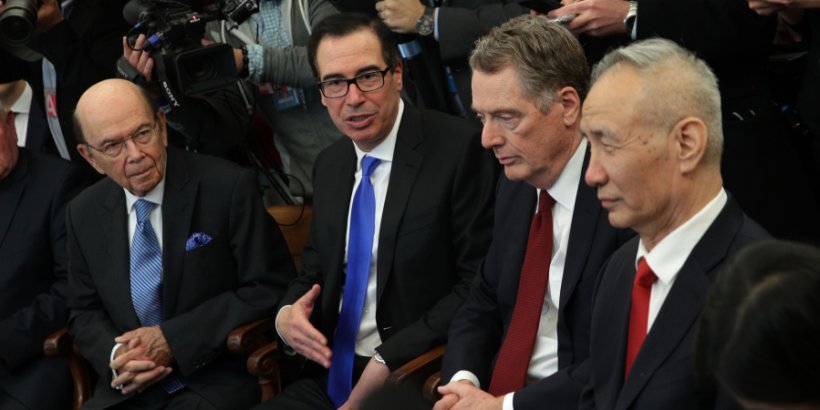The Verdict Is In The Markets: Analyzing The Outcome Of US-China Trade Negotiations

Table of Contents
Phase One Deal: A Temporary Truce?
The Phase One trade deal, signed in January 2020, was hailed as a temporary truce in the escalating US-China trade war. This agreement aimed to de-escalate tensions and address some of the most pressing trade imbalances. However, its long-term effectiveness remains a subject of debate.
- Key concessions from both sides: China committed to purchasing a significant amount of US agricultural products, while the US reduced some tariffs.
- Impact on specific sectors: The agricultural sector in the US saw a boost from increased Chinese demand for soybeans and other products. However, the technology sector remained a significant point of contention.
- Short-term market response: Global markets reacted positively to the signing of the Phase One deal, with a temporary surge in stock prices and a slight strengthening of the Chinese Yuan.
- Analysis of whether the deal truly resolved underlying tensions: While the Phase One deal provided some relief, it did little to address the fundamental issues driving the trade war, including intellectual property rights, technology transfer, and market access. The underlying tensions persisted, casting doubt on its long-term viability.
Escalation and Retaliation: Analyzing the Trade War's Impact
The period leading up to the Phase One deal was marked by escalating tariffs and retaliatory measures from both the US and China. This trade war significantly impacted global supply chains and economic growth.
- Impact on supply chains: Businesses faced disruptions as tariffs increased the cost of imported goods and forced companies to rethink their supply chain strategies. Many companies diversified their sourcing to reduce reliance on either country.
- Effects on inflation and consumer prices: Tariffs led to increased prices for consumers in both countries, contributing to inflation and dampening economic growth.
- Analysis of the winners and losers: While some sectors, such as domestic agriculture in the US, benefited from increased protection, many businesses suffered from the increased costs and reduced market access. The trade war was far from a zero-sum game.
- The role of specific industries: Industries like semiconductors and rare earth minerals became key battlegrounds in the trade war, highlighting the strategic importance of technology and resource control.
Post-Phase One: Shifting Sands and Future Negotiations
Following the Phase One deal, the relationship between the US and China remains complex and characterized by ongoing disputes. While the immediate threat of a full-blown trade war has subsided, new challenges have emerged.
- Continued disputes and areas of ongoing tension: Issues such as technology competition, particularly concerning 5G and semiconductors, and the status of Taiwan continue to be major points of friction.
- Discussion of potential for future trade agreements: While a comprehensive trade agreement remains elusive, there is potential for targeted negotiations on specific issues.
- Impact of geopolitical factors: The broader geopolitical landscape, including increasing global competition and strategic rivalry, significantly influences the trajectory of US-China trade relations.
- Market predictions and investor sentiment: Investor sentiment remains cautious, with the future direction of US-China trade relations a key factor influencing market forecasts and investment decisions.
Market Indicators: Reading the Tea Leaves
Analyzing market indicators provides crucial insight into the impact of US-China trade negotiations. The fluctuations in various markets reflected the changing dynamics of the relationship.
- Stock market performance (US and China): Stock markets in both countries experienced volatility during periods of escalation, with drops correlating to negative trade news and rises following positive developments.
- Currency fluctuations (USD, CNY): The value of the US dollar and Chinese Yuan fluctuated in response to changes in trade policy and market sentiment.
- Commodity prices (e.g., soybeans, oil): Commodity prices, particularly those of goods heavily impacted by trade restrictions, experienced significant price swings reflecting the shifting dynamics of the US-China trade relationship.
- Analysis of investor behavior and sentiment: Investor behavior has been largely reactive, with shifts in sentiment mirroring the ups and downs of the negotiations.
Conclusion
The ongoing evolution of US-China trade negotiations significantly impacts global markets. Analyzing market reactions to various phases reveals a complex interplay of winners and losers, with periods of both optimism and anxiety. While the Phase One deal offered temporary respite, underlying tensions remain. Continued disputes over technology and geopolitical factors suggest that the future of US-China trade relations remains uncertain. Understanding the intricacies of US-China trade negotiations is essential for navigating the complexities of the global market. Stay informed on future developments and their impact on your portfolio by regularly checking reputable financial news sources. Continue to follow the evolution of US-China trade relations to make informed decisions.

Featured Posts
-
 Yomu Sogodni 65 Ridkisni Dityachi Foto Printsa Endryu
May 12, 2025
Yomu Sogodni 65 Ridkisni Dityachi Foto Printsa Endryu
May 12, 2025 -
 Voyna V Ukraine Dzhonson Protiv Mirnogo Plana Trampa
May 12, 2025
Voyna V Ukraine Dzhonson Protiv Mirnogo Plana Trampa
May 12, 2025 -
 Landmark 10 Year Agreement Signed Between Ottawa And Indigenous Capital Group
May 12, 2025
Landmark 10 Year Agreement Signed Between Ottawa And Indigenous Capital Group
May 12, 2025 -
 John Wick 5 Why We Dont Need Another Sequel
May 12, 2025
John Wick 5 Why We Dont Need Another Sequel
May 12, 2025 -
 Adam Sandlers Massive Net Worth A Look At Comedys Earning Power
May 12, 2025
Adam Sandlers Massive Net Worth A Look At Comedys Earning Power
May 12, 2025
